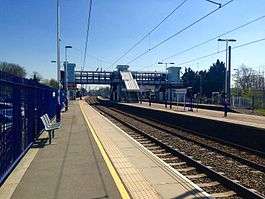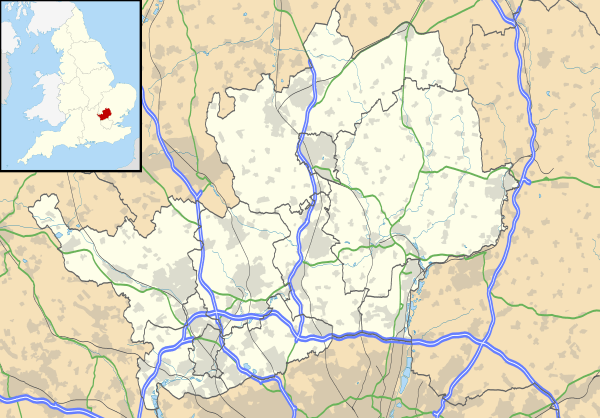Harpenden railway station
Harpenden railway station is on the Midland Main Line in England, serving the town of Harpenden, Hertfordshire. It is 24 miles 51 chains (39.7 km) down the line from London St Pancras and is situated between St Albans City to the south and Luton Airport Parkway to the north. Its three-letter station code is HPD.
| Harpenden | |
|---|---|
 Facing South from platform 1 (Southbound) at Harpenden | |
 Harpenden Location of Harpenden in Hertfordshire | |
| Location | Harpenden |
| Local authority | City of St Albans |
| Grid reference | TL137142 |
| Managed by | Thameslink |
| Station code | HPD |
| DfT category | D |
| Number of platforms | 4 |
| Accessible | Yes |
| National Rail annual entry and exit | |
| 2014–15 | |
| 2015–16 | |
| 2016–17 | |
| 2017–18 | |
| 2018–19 | |
| – interchange | 1,109[1] |
| Key dates | |
| 1868 | Opened |
| Other information | |
| External links | |
| WGS84 | 51.815°N 0.352°W |

The station is served by Govia Thameslink-operated trains on the Thameslink route.
History
Harpenden was the second station built in the town, by the Midland Railway in 1868 on its extension to St. Pancras. Nothing remains of the original station buildings. Although located on Station Road, the road is actually named after the first station, Harpenden East, which was built in 1860 and closed in 1965.
A branch line, built by the Hemel Hempstead Railway Company in 1877, known as the Nickey Line but operated by the Midland, formerly diverged from the main line north of the station. The intention had been to meet the LNWR at Boxmoor, but the section from Hemel Hempstead never had a passenger service. In 1886, a south curve was added to the junction allowing passengers to join the London trains at Harpenden rather than Luton.[2] The branch was closed in 1979, but the route remains in use as a cycleway, passing under the M1 in a tunnel.
A row of five brick built former coal merchant's offices along the station approach are now used as small retail and office units.
Facilities
The station has facilities toilets, a newsagent, dry cleaner, taxi office and rank, and a coffee shop.
The station also has ticket machines on both sides of the station.
The station has a PlusBus scheme where train and bus tickets can be bought together for a cheaper price.
All four platforms have been extended to support 12-carriage trains, as part of the Thameslink programme; this also required the widening of a road bridge. Work on these started on 21 November 2010 and was completed in May 2011.[3] The construction of a new footbridge, with lifts for disabled access, has been completed and links up all four platforms. and[4] The east side of the station (platform 1 side) has two entrances, both with ticket gates to ease congestion during peak times. The west side entrance is where the ticket office is located, but it also has ticket machines.
An extra deck of parking spaces is planned to be built on top of the existing east side car park. When completed, it will add an extra 200 parking spaces.[5]
Services
2006/07 services
The typical off-peak service pattern saw six trains per hour in each direction, operated by First Capital Connect. Four of these were fast trains between Bedford and Brighton, via King's Cross Thameslink station in central London and Gatwick Airport. The remaining two trains called at all stations between Luton and Sutton (in South London).
December 2007
Following the closure of King's Cross Thameslink station, trains on the Thameslink route now operate between Bedford, Luton, Sutton and Brighton calling at the new low level platforms at St Pancras.
East Midlands Railway operates trains on the Midland Main Line route from St Pancras International to/from Leeds, Sheffield, Derby, Nottingham and Leicester through the station, but do not stop. Interchange with these trains can be made one or two stops to the north, either at Luton or Luton Airport Parkway, dependent on the service.
2009
From March 2009, First Capital Connect, in partnership with Southeastern, began running a Luton-Sevenoaks service, which called at Harpenden.
Thameslink
Following completion of the Thameslink Programme in 2018, the following off-peak services are in operation:
- 4tph between Bedford and Gatwick (semi-fast):
- 2tph continue to Brighton;
- 2tph between Luton and Rainham (stopping).
| Wikimedia Commons has media related to Harpenden railway station. |
| Preceding station | Following station | |||
|---|---|---|---|---|
| Luton Airport Parkway | Thameslink Thameslink |
St Albans City | ||
| Disused railways | ||||
Roundwood Halt Line and station closed | Midland Railway Nickey Line | Terminus | ||
References
- "Station usage estimates". Rail statistics. Office of Rail Regulation. Please note: Some methodology may vary year on year.
- Radford, B., (1983) Midland Line Memories: a Pictorial History of the Midland Railway Main Line Between London (St Pancras) & Derby London: Bloomsbury Books
- "Archived copy". Archived from the original on 24 November 2010. Retrieved 1 January 2011.CS1 maint: archived copy as title (link)
- "Archived copy". Archived from the original on 17 July 2011. Retrieved 1 June 2010.CS1 maint: archived copy as title (link)
- White, Debbie. "Extra deck planned for Harpenden station car park".
Sources
- Butt, R. V. J. (1995). The Directory of Railway Stations: details every public and private passenger station, halt, platform and stopping place, past and present (1st ed.). Sparkford: Patrick Stephens Ltd. ISBN 978-1-85260-508-7. OCLC 60251199.
External links
| Wikimedia Commons has media related to Harpenden railway station. |
- Train times and station information for Harpenden railway station from National Rail
